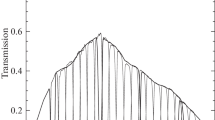Abstract
Quasars of high redshift (here z > 3.3) are the most distant objects known and provide direct information on the early Universe. However, only a few high-redshift quasars have been discovered and their detection remains problematic. We report here the discovery of a quasar (0046 – 293) with a redshift z = 4.01 and another (0044–276) with a redshift z =3.42. The redshift of the former quasar is the highest yet detected and compares with the z = 3.80 of the previous most distant known quasar1. The new quasars lie in the same field as three other known high-redshift quasars1,2 and were identified in a preliminary analysis of new multi-colour data derived from measurements of direct photographic plates taken with the United Kingdom Schmidt Telescope (UKST). The two new quasars are significantly fainter (mR>19) than previously known high-redshift quasars discovered by optical techniques, and demonstrate that the luminosity function of optically selected high-redshift quasars extends over at least two· magnitudes.
Similar content being viewed by others
References
Hazard, C., McMahon, R. G. & Sargent, W. L. W. Nature 322, 38–40 (1986).
Shanks, T., Fong, R. & Boyle, B. J. Nature 303, 156–158 (1983).
Osmer, P. S. Astrophys. J. 253, 28–37 (1982).
Schmidt, M., Schneider, D. P. & Gunn, J. E. Astrophys. J. 310, 518–533 (1986).
Koo, D. C., Kron, R. G. & Cudworth, K. M. Publ. astr. Soc. Pac. 98, 285–306 (1986).
Boyle, B. J., Fong, R., Shanks, T. & Peterson, B. A. Mon. Not. R. astr. Soc. (in the press).
Kibblewhite, E. J., Bridgeland, M. T., Bunclark, P. S. & Irwin, M. J. Proc. Astronomical Microdensitometry Conf., 277–287 (NASA, Washington DC, 1983).
Bunclark, P. S. & Irwin, M. J. Proc. Statistical Methods in Astronomy Symp., Strasbourg 195–200 (ESA SP-201, 1983).
Irwin, M. J., McMahon, R. G. & Hewett, P. C. Measuring Machines, 5–6 (Newslett. No. 8. SERC, London, 1985).
UKSTU Handbook (Royal Observatory, Edinburgh, 1983).
Sargent, W. L. W., Filippenko, A. V., Steidel, C. C., Hazard, C. & McMahon, R. G. Nature 322, 40–42 (1986).
Author information
Authors and Affiliations
Rights and permissions
About this article
Cite this article
Warren, S., Hewett, P., Irwin, M. et al. First observation of a quasar with a redshift of 4. Nature 325, 131–133 (1987). https://doi.org/10.1038/325131a0
Received:
Accepted:
Issue Date:
DOI: https://doi.org/10.1038/325131a0
- Springer Nature Limited





